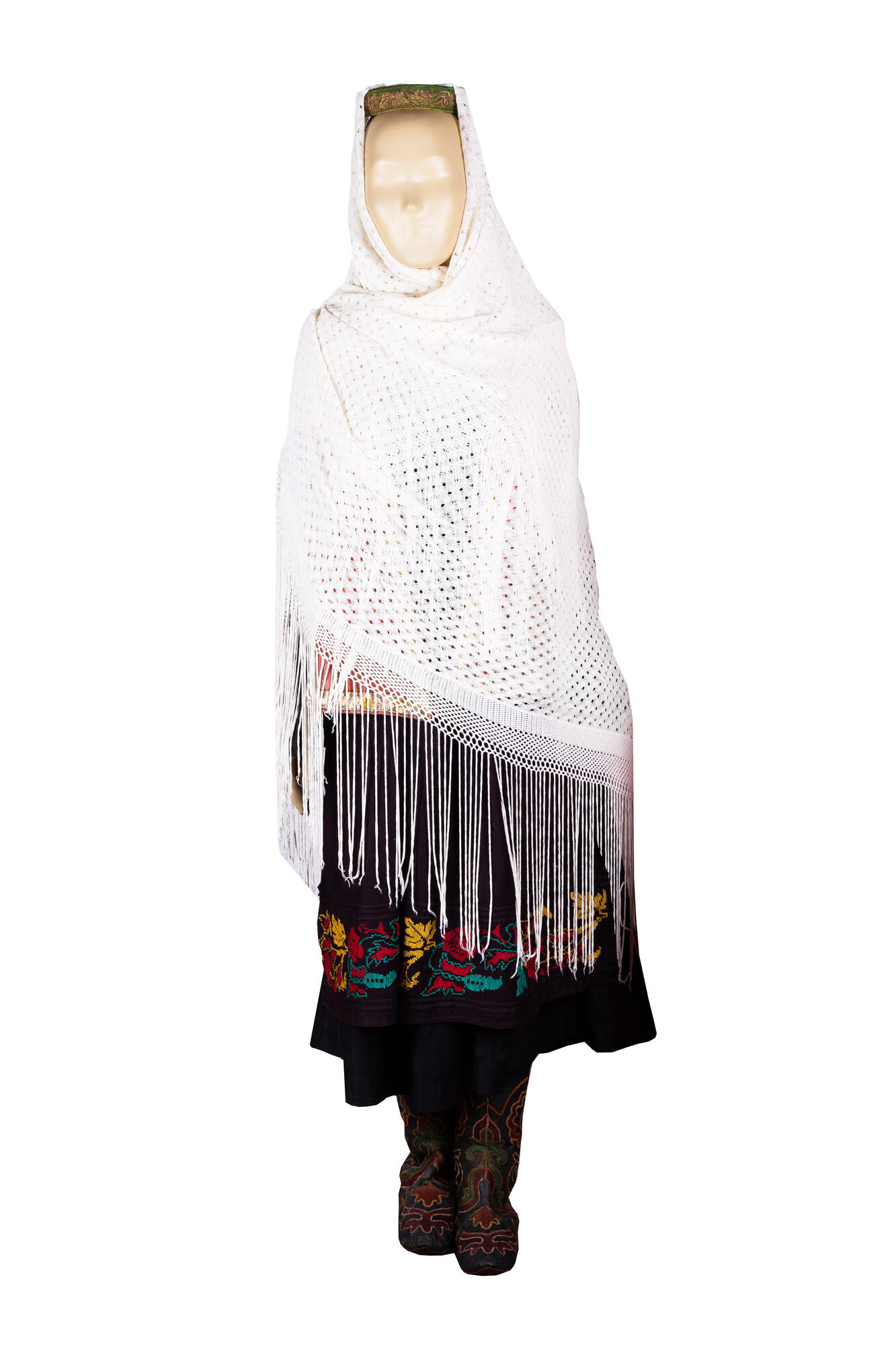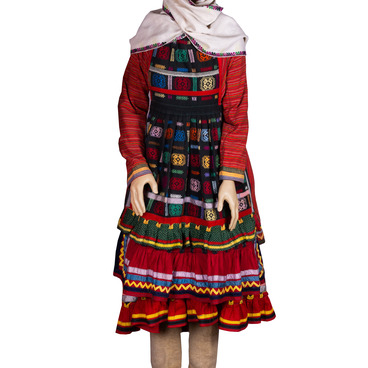The traditional clothing that Tatars wore changed in tune with the folk culture. Until the second half of the 19th century, Tatar national clothing was sewn mainly from fabrics produced as handicrafts in households, and only merchants could afford garments from imported linen and hemp fabrics. Later on, factory-made fabrics began to spread among the Tatar peasantry, including chintz, muslin, and ticking, and wealthy Tatars ordered clothes made of silk, wool, and particularly often from heavy, luxurious brocade.
The museum’s collection showcases a women’s Tatar costume made in the 20th century. And that is why it is distinguished by the wide variety of materials used to make it. Among the items that make up this costume, some that stand out are a large white knitted shawl, a traditional headdress called a kalfak, a light apron, and refined, lightweight moccasins — light shoes with a soft toe and an elastic inner counter. Interestingly, traditional Tatar women’s clothing has a lot in common with men’s, including its cut, the materials, and even names. For example, the oldest type of women’s shirt was no different in cut from a man’s: it was a tunic-like, long shirt made of white canvas, with embroidery at the collar, along the chest section, and along the edges of the sleeves.
Trousers, which were in the past an indispensable element of the traditional attire for Tatar women, also did not differ at all from men’s in terms of their cut, and took the form of a typical version of trousers with a wide crotch area — something which was common among many nomadic peoples. Back when homespun fabrics prevailed, they were sewn from dyed monochromatic cloth, which was most often blue, green, or red. Later, trousers made of motley — coarse linen or cotton fabric — entered into everyday use. With the spread of factory-made fabrics, trousers began to be sewn from chintz, sateen, and other lightweight materials.
Tatar women usually wore camisoles and aprons over their shirts. Lying at the heart of the cut, the women’s camisole also differed little from the man’s, except that it was more fitted and widened toward the bottom. Women’s camisoles at the turn of the 20th century were not wrapped around, and their flaps were connected in the middle or lower part of the chest area with a decorative, double-sided fastener called a kaptyrom. Tatars paid particular attention to the coloring in all items in their wardrobes. The most widespread were blue, yellow, green, pink, crimson, and lilac colors, with burgundy and red colors somewhat less often.
The museum’s collection showcases a women’s Tatar costume made in the 20th century. And that is why it is distinguished by the wide variety of materials used to make it. Among the items that make up this costume, some that stand out are a large white knitted shawl, a traditional headdress called a kalfak, a light apron, and refined, lightweight moccasins — light shoes with a soft toe and an elastic inner counter. Interestingly, traditional Tatar women’s clothing has a lot in common with men’s, including its cut, the materials, and even names. For example, the oldest type of women’s shirt was no different in cut from a man’s: it was a tunic-like, long shirt made of white canvas, with embroidery at the collar, along the chest section, and along the edges of the sleeves.
Trousers, which were in the past an indispensable element of the traditional attire for Tatar women, also did not differ at all from men’s in terms of their cut, and took the form of a typical version of trousers with a wide crotch area — something which was common among many nomadic peoples. Back when homespun fabrics prevailed, they were sewn from dyed monochromatic cloth, which was most often blue, green, or red. Later, trousers made of motley — coarse linen or cotton fabric — entered into everyday use. With the spread of factory-made fabrics, trousers began to be sewn from chintz, sateen, and other lightweight materials.
Tatar women usually wore camisoles and aprons over their shirts. Lying at the heart of the cut, the women’s camisole also differed little from the man’s, except that it was more fitted and widened toward the bottom. Women’s camisoles at the turn of the 20th century were not wrapped around, and their flaps were connected in the middle or lower part of the chest area with a decorative, double-sided fastener called a kaptyrom. Tatars paid particular attention to the coloring in all items in their wardrobes. The most widespread were blue, yellow, green, pink, crimson, and lilac colors, with burgundy and red colors somewhat less often.



